| dc.contributor.author | Aydoğan, Doğan | |
| dc.date.accessioned | 2017-07-05T12:51:29Z | |
| dc.date.available | 2017-07-05T12:51:29Z | |
| dc.date.issued | 2016-12 | |
| dc.identifier.uri | https://hdl.handle.net/20.500.11776/1795 | |
| dc.description | International Congress of Management Economy And Policy, 26-27 Kasım 2016, İstanbul | en_US |
| dc.description.abstract | Sınıf ve statüye dayalı göstergelerin birleştiği, düzenlendiği, tekrar üretildiği ve toplumsal tabakalaşmanın daimi bir temsilcisi olarak varlığını koruduğu bir alan olarak moda; insan bedeni ve bedeni süsleme, giyinme biçimlerini yakından etkilemektedir. Tüketim toplumu koşullarında seri üretime dayalı görece düşük kaliteli malların üretimi ve küresel iletişim araçlarının tarzları hızla değiştirdiği bir ortamda, giyim sektörünün ürettiği moda imgeleri de hızla değişmekte ve yenilerinin sürekli üretimi gerekmektedir. Bu bağlamda hazır giyim markaları ile imgenin yaratımı ve reklam arasında zorunlu ve yoğun bir ilişki doğmaktadır. Güzellik kavramının içeriği kültür ve toplumlara göre değişiklik gösterir. Bu farklılaşmaya karşın küresel çağda güzellik kavramı, küresel medya merkezlerinin dinamikleriyle biçimlenmektedir. Çevre ülkelerin ve kültürlerin biçimsel unsurları merkeze taşınmakta ve burada küresel pazara uygun hale getirilerek iletişim araçlarından yayılmaktadır. Bu durum küreselleşme ile birlikte moda ve beden kavramlarının tek tipleşmesini doğurmakta, küresel merkezlerde üretilen biçimler bütün dünyayı sarmaktadır. Bu noktada etik açıdan çok daha önemli bir sorun ortaya çıkmaktadır. Bütün markalar çocukları ele geçirmek üzere reklam ve ürün geliştirmek isterler, çocuk tarafından benimsenen bir marka bir ömür boyu aynı kişiye satış yapabilecektir. Buna karşın medya üzerinden üretilen güzellik kavramı genç yetişkinleri hedeflemekte ve onların güzel algısı ile şekillenmektedir. Bu durum da çocuk bedeni, çocuk gelişimi ve çocuk sağlığına uygun olmayan içeriklerin medyada özellikle reklam içeriklerinde yer almasına ve yetişkin algısının çocuk ihtiyaçlarını görmezden gelerek, kendi haz ve estetik arzusunu çocuğa dayatmasına yol açmaktadır. Çalışma bağlamında incelenen “Tarzı Olan Çocuklar- KOTON” reklamında göstergebilim yöntemine göre inceleme yapılmıştır. Reklam filmi anlamı oluşturan yapısal unsurlarına bölünerek ele alınmış ve söylem üzerinden üretilen ideolojik yapı ortaya çıkarılmıştır. Moda, moda endüstrisi, reklam ve çocukluk arasında ortaya çıkan bu ilişkinin etik bir sorun yaratmanın yanında, çocuk gelişimine aykırı bir içerik ürettiği ve çocuk hakları bağlamında ele alınması gerektiği önerilmektedir. | en_US |
| dc.description.abstract | Fashion is the phenomenon in which class and statue-based representations are organized, reproduced and maintained as a permanent representative of social stratification; closely affects the human body, body adornment and dressing styles. In an environment based on serial production, relative low quality goods and global communication tools change styles quickly in the context of consumer society; the fashion images produced by the textile sector are also rapidly changing and the continuous production of images and styles are required. In this context, there is a compulsory and intense relationship between ready-made brands and the creation and fashion based advertisement images. The content of the concept of beauty varies according to culture and societies. Despite this differentiation, in the global age the concept of beauty is shaped by the dynamics of global media centers. The style elements of the periphery countries and cultures are moved to the global media center bu the communication tools and from here being adapted to the global market. This situation with globalization, leads to the singularity of the concepts of fashion and body, The forms produced in global centers surround the whole World. At this point, a much more important problem emerges in terms of ethics. All brands want to develop advertising and products to capture children, and a brand adopted by the child will be able to sell to the same person for a lifetime. On the other hand, the concept of beauty produced through the young adults as a media targets and is shaped by their beauty perception. This situation leeds the child-based fashion advertisements shaped by adult beauty perception and ignores child body, child development, child health and childhood reality. In the context of the study, the "KOTON- children with styles " advertisement was examined according to the methodology of semiotics. The advertising film was divided into structural elements that constitute meaning and the ideological structure produced through discourse was revealed. This relationship between fashion, fashion industry, advertising and childhood creating an ethical problem, in addition producing contrary content to child development and It should be considered in the context of children's rights. | en_US |
| dc.language.iso | tur | en_US |
| dc.publisher | Namık Kemal Üniversitesi,İktisadi ve İdari Bilimler Fakültesi | en_US |
| dc.rights | info:eu-repo/semantics/openAccess | en_US |
| dc.subject | Reklam | en_US |
| dc.subject | Pazarlama | en_US |
| dc.subject | Çocuk | en_US |
| dc.subject | Hızlı Moda | en_US |
| dc.subject | Göstergebilim | en_US |
| dc.subject | Advertisement | en_US |
| dc.subject | Marketing | en_US |
| dc.subject | Child | en_US |
| dc.subject | Fast Fashion | en_US |
| dc.subject | Semiotics | en_US |
| dc.title | HAZIR GİYİM MODA REKLAMLARI VE ÇOCUK BEDENİNE YÖNELİK İMGESEL BASKI: KOTON ÖRNEĞİ | en_US |
| dc.title.alternative | READY TO WEAR FASION ADVERTISEMENTS AND CONSTRAINT BY THE IMAGE TO THE CHILD BODY:"KOTON" CASE | en_US |
| dc.type | article | en_US |
| dc.relation.ispartof | Balkan Sosyal Bilimler Dergisi | en_US |
| dc.department | Tekirdağ Namık Kemal Üniversitesi Dergileri | en_US |
| dc.authorid | 124735 | en_US |
| dc.identifier.startpage | 277 | en_US |
| dc.identifier.endpage | 288 | en_US |
| dc.relation.publicationcategory | Makale - Ulusal Hakemli Dergi - Kurum Öğretim Elemanı | en_US |



















